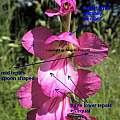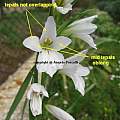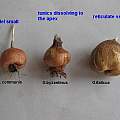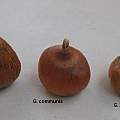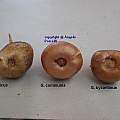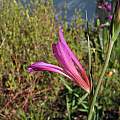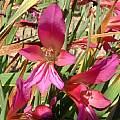Gladiolus species on this page are from Southern Italy.
Gladiolus index - Southern African Gladiolus A-B - Southern African Gladiolus Ca - Southern African Gladiolus Ce-E - Southern African Gladiolus F-H - Southern African Gladiolus I-Me -- Southern African Gladiolus Mi-Pa - Southern African Gladiolus Pe-R - Southern African Gladiolus S-T - Southern African Gladiolus U-Z - Gladiolus Hybrids - Miscellaneous Gladiolus
Gladiolus of Southern Italy, an article by Angelo Porcelli, originally appeared in The Bulb Garden Volume 10, Issue 1, Winter, 2011. All photos by Angelo Porcelli unless otherwise noted.
I have written this to help people understand and recognize the differences between the species of European Gladiolus most commonly cultivated and seen in their natural habitat. All my considerations are based on Flora d'Italia (1982) by Prof. S.Pignatti , which is the reference on the Italian flora used in all universities in Italy. We are awaiting a new edition of this book which is close to publication. You might not know that in Italy there are eight of the so-called Eurasian Gladiolus species, which are rather similar in appearance, all having a more or less pink-magenta color. Without close observation of some details it is easy to confuse them. In Southern Italy there are five species: G. italicus (which is present throughout Italy), G. byzantinus, G. communis, G. dubius, G. inarimensis. All the taxonomic keys are based on features that are often very diffucult to check, for example, length of filaments compared to anthers, size and shape of seeds, shape of tunics of the corm. The observer can't have all the keys present at the same time; that is, if you are checking length of filaments on a fresh flower, you can't check the seeds at the same time. So for positive identification one needs to wait a whole year in order to check them all.
I will start with the lesser-known species and say just a few words about them.
Gladiolus dubius as the specific name indicates, is in fact a doubtful species. The Kew List of Monocots reports a Gladiolus × dubius Guss., Fl. Sicul. Prodr., Suppl.: 8 (1832) as a hybrid between G. communis and G. illyricus. This is quite unlikely because G. illyricus is found in Italy only in the foothills of the Eastern Alps in Friuli near the Slovenia border, while G. Gussone (1787-1866) described the species from samples collected in Sicily, which is more than 1,000 kilometers (about 621 miles) away. Apart from the geographic distance, Pignatti reports valid taxonomic keys, so while G. illyricus is surely a valid species, the G. dubius described by Gussone could even be an ecotype of G. communis/byzantinus or an aberrant form, as well as a genuine species. I don’t have any material, so I can’t compare it and make any conclusion.
Another lesser-known species, Gladiolus inarimensis, is endemic to Sardinia and some small islands in the Thyrrenian Sea (Ischia, Capri, Pianosa). Although Kew lists it as synonymous of with G. italicus there are at least two taxonomic keys to separate these species, one of them being seeds that are not winged. Because of the narrow habitat, it's quite possible it has never been introduced into cultivation. I have wild-collected saples still to check, so I will skip further consideration of this species.
Our main discussion concerns the great confusion that exists around Gladiolus byzantinus and G. communis. As these species are rather showy, they have been in cultivation for a long time in Europe and worldwide, but not by the Italians, who often ignore their presence as elements of our native flora. The species names byzantinus and communis are often given as synonyms and you often see G. byzantinus ssp. communis, G. communis ssp byzantinus, and G. communis var. byzantinus… a true nightmare!
In his Flora d'Italia Prof. S.Pignatti treats them as separate species and as he is a well-known "lumper"; I have always thought if he mentions them as true separate species, he's probably very sure of this. I have always tried to understand these confusing species, checking all material available, both from my collections in habitat, and from commercial sources.
The first consideration is the difference between G. italicus and G. byzantinus/communis. This is quite straightforward: observing the flowers makes it rather easy and looking at seeds and corms makes it absolutely certain. G. italicus is the only species that doesn’t make winged seeds; they are like small pepper grains with three to four angles. Its flowers are easy to tell apart from those of the other two species as they have an "open" shape, the lateral tepals are oblong, narrow and well spaced, not overlapping the upper tepal and the two lower ones. This species is highly bulbilliferous, it increases by cormlets at an alarming rate and a single corm will turn in a clump in a few years. This is the reason that all vendors selling cheap G. byzantinus are actually selling the more prolific G. italicus.
About the color there’s more to say. Many claim that G. byzantinus is a rich dark purple while G. italicus is a pale, dull copy, but actually that isn’t so. I have seen some photos of G. italicus that show really ugly forms, pale and small, almost deformed, and I wonder who introduced them into cultivation, seeing that in nature there are many nice, strong, colorful plants.
G. italicus grows mainly in corn fields and it's not known to grow wild naturally, being always connected with human presence. We speculate it came into Italy with seeds (durum wheat that we grow in Apulia) in ancient times, probably from the Middle East. It has a reproductive cycle shorter than wheat so it doesn’t resent harvesting and subsequent deep plowing, which actually helps it to spread better. It is considered a pest in agriculture ("Cyperaceae, Iridaceae and Commelinaceae as weeds," by M. Colasante, G. Corazzi, and R. Mortellaro, 5th International Conference, Ecology of Invasive Alien Plants, 13-16 October 1999, La Maddalena, Sardinia, Italy).
A white form is in cultivation, wandering around as a white G. byzantinus that we should call forma alba, which would be really a gem if it existed. Although I find references in some Italian gardening literature, again as white byzantinus, it seems that no one has ever seen a white G. italicus and, to be honest, I have never found any, having seen thousands of plants in their native habitat.
More subtle is the difference between G. communis and G. byzantinus. Both species grow only in southern Italy, the latter being subendemic. Their habitats are arid lawns, garigues (low open scrubland found in poor or dry soil in the Mediterranean region) and maquis (scrubland composed primarily of leathery, often aromatic broad-leaved evergreen shrubs or small trees).
In spite of the specific name G. communis, this species is not at all common.I rate it as quite rare, difficult to meet if you don't go to the right habitat. Both species don’t increase by cormlets and are solitary in habitat; it’s just in cultivation that they make offsets thanks to good soil and feedings. They both make a ring of very small cormlets at the base of the new corm, but they stay dormant and entangled in the older tunics unless the main corm is damaged or dug by wild pigs, mice or porcupines.
The flowers of both species are very similar, so close examination is required to tell them apart, but once you understand the key this will be easy. They have larger flowers than G. italicus and plants are taller. G. italicus averages 20 to 23 inches (50-60 cm), while G. communis and G. byzantinus grow up to 40 inches (100 cm). The main way to tell them apart is the by the shape and size of the three lower tepals. In G. communis they are more or less of the same length and width, while in G. byzantinus the central one is visibly longer and even wider. The upper central tepal is hooded in G. communis, but it points up in G. byzantinus. The median tepals have a "spoon" shape in the former and "rhombus" shape in the latter. Color is also a bit different: G. communis often has a slight two-tone effect on the lower tepals, but this is not a reliable feature, as many individuals are a solid color, while G. byzantinus is usually a dark rich purple. I see a strain or form called "cruentu" in the United States, but I am not aware of any reference or the origin of it and, in any case, it looks to me as just a true good form of byzantinus.
The other true difference is the seed shape and size. Both species have winged seeds, but Gladiolus byzantinus has large seeds of about 1 cm, while G. communis seeds are 3 to 5 mm. Plants of G. byzantinus have broader leaves and are usually more robust, while plans of G. communis are usually slimmer and taller, hence the common name of "greater gladiolus."
I grow all the species in the same place and they have distinct and well-defined flowering times. G. italicus is the earliest (late March), followed by G. byzantinus (late April) and finally G. communis (late May, but in habitat mid-June, as I always find it at 1,600 feet, or 500 meters, and higher).
Even the corms have visible differences in fibers. G. italicus has a peculiar net on the tunics, especially on the top of the corm, and a rather light brown color. It's especially easy to pick out even in a batch of corms of mixed species. The other two species are more similar, but G. communis has tunics with very close parallel veins, while G. byzantinus has tunics that dissolve (separate) at the apex with parallel but much wider veins and this is a another valid key.
Gladiolus communis subsp. byzantinus is native to southern Spain, Sicily, and northern Africa. It is deep purple-red with narrow, paler marks outlined in dark purple on the lower lobes. These plants were blooming at Kew Gardens in May 2004. Photo by Bob Rutemoeller.
Gladiolus illyricus is native to south and west Europe and the Mediterranean region, growing on heaths, in scrub and open woods. It flowers April to August and is similar to G. communis with flowers facing in two directions but is usually shorter with 3 to 10 flowers on a rarely branched stem. Flowers are magenta purple with white markings on the lower 3 lobes. Photos taken by Mary Sue Ittner of plants grown from seed labeled this and hopefully are correctly identified.
Gladiolus italicus has a broad distribution from southern Europe to parts of Asia growing on rocky hillsides, grassy areas, open forests and in fields. It flowers from March to July. It is distinguished from other European Gladiolus by having anthers that are longer than the filaments. Flowers are loosely arranged and facing various directions, pale pink as well as purple-pink to magenta with a pale blotch outlined in purple on the lower lobes. There are 5 to 15 flowers on the spike. Photos 1-2 taken by Mary Sue Ittner show the flowers of a plant grown from seed labeled G. italicus. Photo 3 was taken by Nhu Nguyen. Photo 4 is a close-up taken in habitat by Angelo Porcelli.
Gladiolus sp. The photo below shows a plant grown from seed obtained from Monocot Nursery under the name Gladiolus dubius, which I cannot verify. The Kew monocot list states that name is an invalid name for Gladiolus italicus. It has relatively large flowers for a Eurasian species. Photo by Jane McGary
Gladiolus index - Southern African Gladiolus A-B - Southern African Gladiolus Ca - Southern African Gladiolus Ce-E - Southern African Gladiolus F-H - Southern African Gladiolus I-Me -- Southern African Gladiolus Mi-Pa - Southern African Gladiolus Pe-R - Southern African Gladiolus S-T - Southern African Gladiolus U-Z - Gladiolus Hybrids - Miscellaneous Gladiolus

